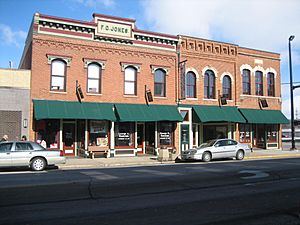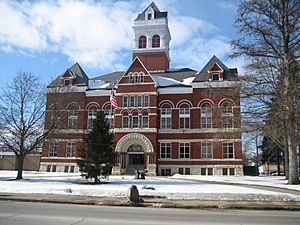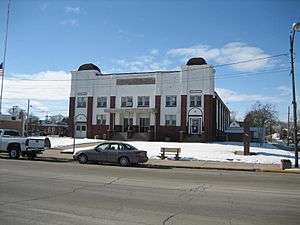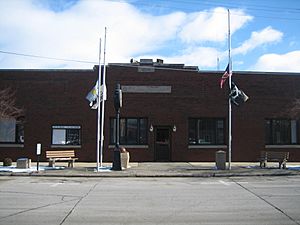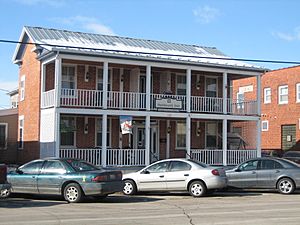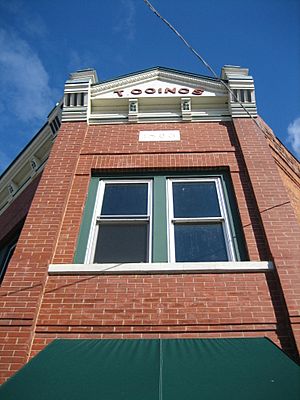Oregon Commercial Historic District facts for kids
The Oregon Commercial Historic District is a special area in Oregon, Illinois. It's like a protected neighborhood filled with old, important buildings. This district was added to the National Register of Historic Places in 2006.
The district is generally found between Jefferson, Franklin, 5th, and 3rd Streets in Oregon. It is one of six places in Oregon that are listed on the National Register. Two other places, the Oregon Public Library and the Chana School, were also added around the same time.
Quick facts for kids |
|
|
Oregon Commercial Historic District
|
|
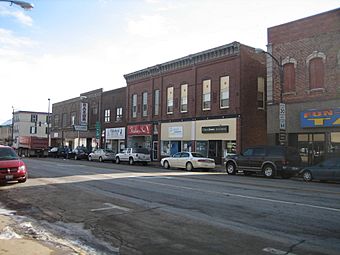
Historic buildings in the 300 Block of Washington Street, Oregon, Illinois.
|
|
| Location | Roughly bounded by Jefferson, Franklin, 5th and 3rd Sts., Oregon, Illinois |
|---|---|
| Area | 0 acres (0 ha) |
| Built | Various |
| Architect | Pond & Pond; Taft, Lorado |
| Architectural style | Italianate, Queen Anne, Romanesque Revival, Classical Revival, Art Deco, Arts and Crafts, Art Nouveau, Art Moderne, Colonial Revival |
| NRHP reference No. | 06000713 |
| Added to NRHP | August 16, 2006 |
Contents
What's Inside the District?
The Oregon Commercial Historic District covers about 30 acres. It includes 62 buildings and other items. Most of these, 51 to be exact, are called "contributing properties." This means they help show the history and special character of the district.
These contributing properties include 44 buildings, two structures, and five objects. There are also eleven buildings that are "non-contributing." These buildings are either newer or have been changed too much to fit the historical look of the district.
Cool Building Styles
The buildings and objects in this historic district show off many different styles of architecture. You can see designs like Italianate, Romanesque Revival, and Queen Anne. Other styles include Art Nouveau, Art Deco, and Arts and Crafts. These styles have all influenced the look of the commercial buildings in the area.
Important Buildings and Structures
Many buildings in the district are special. Two of them are even listed individually on the National Register of Historic Places. These are the Oregon Public Library and the Ogle County Courthouse. The buildings are used for different things, like businesses, government offices, and even apartments on upper floors.
Besides buildings, you can also find other interesting things. These include cannons, a drinking fountain, sculptures, and a well house.
F.G. Jones Block
The F.G. Jones Block is a two-story building with an Italianate design. It is connected to two other important buildings at Washington and Third Streets. This building is known for having the most detailed decorations of the three.
Jacobs Block
The Jacobs Block is a three-story building also designed in the Italianate style. It was once known as the National Clothing House. This building was constructed around 1870. An aluminum awning was added to its front in the 1960s.
Masonic Temple Lodge No. 420
This three-story building is made of yellow brick. It is located on South Fourth Street. The outside has fancy ivory brick details. Above the second-story door, there is a sign with three round milk glass globes.
Old Ogle County Courthouse
The Romanesque Revival style Ogle County Courthouse stands in the middle of a large public square. While it's not the main courthouse anymore, some county offices still use the first two floors. A Chicago architect named George O. Garnsey designed the building, and it was built in 1891.
Oregon City Hall
The Oregon City Hall was built in 1920. Its front, especially the windows, has been updated over time. This building is still where the city government of Oregon, Illinois operates today.
Oregon Coliseum
The Oregon Coliseum is located at the corner of Fourth and Franklin Streets. This is on the north side of the historic district. The building has a lot of stucco on its outside. Its design is strongly influenced by the Art Deco style.
Oregon Public Library
The Oregon Public Library was designed in the Arts and Crafts style. Its second floor has an art gallery. This gallery shows off works from its collection, including pieces by famous artists like Lorado Taft and Nathaniel Currier.
Oregon Theater
This theater building was built in 1910. It was first called the Star Theater, and later the Oregon Theater. The front of the building was updated around 1940. Even though it's now used for other businesses, it still has its original marquee with "OREGON" written in big neon letters.
Rock River Hotel
The Rock River Hotel is a traditional I-house style building. It was built around the time of the American Civil War. It started as a private home. Later, it became the Rock River Hotel, and then the Blackhawk Hotel. It is the last of three historic hotel buildings that once stood in Oregon.
Schiller Piano Company
The Schiller Piano Company building was once the largest employer in Ogle County. It is a very large industrial building on the north side of the district. The iron base of its old water tower still stands on the property. Both the building and the water tower base are important parts of the historic district.
T. Goings Building
The two-story Italianate T. Goings Building stands out. It has a wooden pediment (a triangular decoration) above its brick parapet (a low wall at the edge of a roof). The name "T. Goings" is carved into it. This red brick building was built in 1895.
The Soldiers' Monument
The Soldiers' Monument is located in the courthouse square. It features three sculptures created by Lorado Taft. The monument also has a special curved bench area designed by architects Allen and Iriving Pond. It was first dedicated to veterans from Ogle County who fought in the Civil and Spanish–American Wars. Later, veterans from World War I were also honored there.
Union Block Opera House
The Union Block, also known as the Hall, Opera House, is a three-story building. It was influenced by the Romanesque Revival style and was built around 1880.
Unity Building
The Unity Building is a very decorative commercial building in the Queen Anne style. It has a large oriel (a window that sticks out from the wall) on its second story. This makes it stand out from nearby buildings, which are in more simple Classical Revival and Italianate styles.
Images for kids




